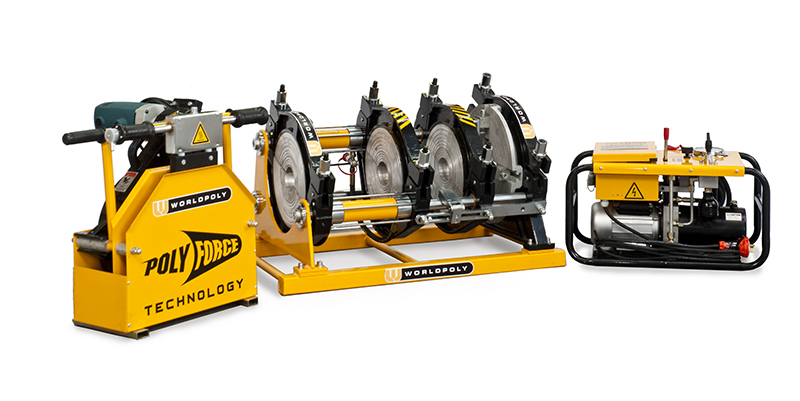Worldpoly News

HIGH PRESSURE WELDING-WHERE DID THAT COME FROM?
06.08.2014
As technology increases and international communication explodes, we sometimes find ourselves faced with new information which is difficult to explain. Even in the relatively sheltered world of PE pipe fusion, we have witnessed the recent inclusion of previously ‘High Pressure’ welding in the ISO and the Australian / New Zealand welding standards. Hopefully we can shed some light on the subject.
While most of the world has been welding at an interface pressure of 0.15 MPa (DVS) or 0.17 MPa (original ISO), North America has had a fusion standard applying more than three times that force - 0.52 MPa. How something so basic could have evolved this way surprises many, but the isolation of North American standards and practices from the rest of the world is not unusual. Yards, ounces, pounds - force and fractions are remembered by many of us, but are still daily life in some countries. Whether ASTM Standards evolved differently to ISO as non-tariff barriers to import, as the result of a lack of desire to coordinate with the rest of the world, or because they believed that they were on to something special will never be known, but the fact is that North America welds at more than three times the pressure used by the rest of us on other than fittings production.
DVS has always been the most conservative standard, providing good welds under the most trying circumstances. ISO SLP (Single Low Pressure) is almost the same as DVS, and is used successfully in most countries. ISO SHP (Single High Pressure) is the same as the North American medium pressure standard, and was recently introduced to Australia with the Queensland Coal Seam Gas project, where welding and other specifications were written in the US, to US Standards. We have seen it also introduced to India only this year, again for a US specified CSG project.
The benefit of the SHP standard is that the total welding time is around half that of SLP, due to a major reduction in cooling time. The downside of SHP welding is that it is not as forgiving as SLP. Site conditions and operator variables must be controlled to a much greater degree than SLP, in order to get consistently acceptable results. Such requirements have gone as far as to introduce welding crawlers, where the fusion takes place in a controlled, positive pressure environment. These units also provide other significant advantages on site including pipe handling, operator OH&S and a significant reduction in labour and support equipment.
Changeover time after heating, crashing of the hot faces, and any air-borne particulate effects all welds, and particularly SHP. For this reason Worldpoly strongly recommends the use of SHP fusion only where well specified and controlled site procedures and quality control are present, the weld zone is covered, only experienced operators are used, the quality of the pipe and fittings is assured, and at least data loggers if not CNC controlled welding machines are used
PolyForce630 S2 Tracked with CNC control and data logging welds at both high and low pressure, simple CNC controls remove operator variables when welding at High pressure.
For more information please contact sales@worldpoly.com


Worldpoly News
- OLDEST CITY BUILDS WASTE WATER TREATMENT PLANT
- THE HDPE FOOT VALVES YOU’VE BEEN WAITING FOR
- APS LAUNCH NEW VICTORIAN FABRICATION LOCATION
- 2500MM SMART BUTT WELDER DELIVERED TO TURKEY
- MP Andrew Robb Opens Myanmar's Welding School
- The Earthmover & Civil Contractor Magazine
- PolyForce Technology Being Exhibited at AIMEX
- Compare the PolyForce630 with the other guys
- New Training Manager - Australia & International
- SEGURIDAD EN LA SOLDADURA A TOPE
- SAFETY in Butt Welding - New Benchmark?
- Worldpoly now operating in 105 countries
- UPCOMING CONFERENCES
- HIGH PRESSURE WELDING-WHERE DID THAT COME FROM?
- ETHIOPIA MAKES 101 FOR WORLDPOLY
- When Failure is Not an Option
- AUSTRALIAN-MADE: POLYFORCE SERIES 2
- MAFFRA POLY WITH WORLDPOLY ADDRESS EMERGENCY WELDS
- EVENT FEB 2014 - BUTT FUSION QUALITY ASSURANCE
- 50 YEARS OF POLY EXPERIENCE AND EXPERTISE
- TOUGH MACHINERY FOR A TOUGH TERRAIN
- AUSTRALIAN-MADE POLYROVER(TM)630
- OMAN BEC WELCOMES WORLDPOLYS GUIDANCE
- ANUNCIO DE OFICINA WORLDPOLY LATINO AMERICA
- BHP BILLITON CHILE STICKS TO WORLDPOLY
- TOUGH ENVIRONMENT? OUR SPECIALITY
- WORLDPOLY PROVIDES WATERTIGHT SOLUTIONS
- WE'VE COPPED A TOUGH NEW LOOK
- WORLDPOLY... CATCH OF THE DAY




 Copyright © Worldpoly Australia 2012. ABN 56092 362 260.
Copyright © Worldpoly Australia 2012. ABN 56092 362 260.
